Complete Solutions to EXAMPLE SOLUTION of chapter MOTION OF SYSTEM OF PARTICLES AND RIGID BODIES of Class 11 book with complete answers and questions
| Class 11 | PHYSICS |
| Chapter | MOTION OF SYSTEM OF PARTICLES AND RIGID BODIES |
| TAMILNADU GOVT | EXAMPLE SOLUTION |
| Number Of Questions | 27 |
| Academic Year | 2023-24 |
Two point masses 3 kg and 5 kg are at 4 m and 8 m from the origin on X-axis. Locate the position of center of mass of the two point masses (i) from the origin and (ii) from 3 kg mass.
View SolutionFrom a uniform disc of radius R, a small disc of radius `(R )/(2)` is cut and removed as shown in the diagram. Find the center of mass of the remaining portion of the disc.
View SolutionThe position vectors of two point masses 10 kg and 5 kg are `(-3hati+2hatj+4hatk)m` and `(3hati+6hatj+5hatk)m` respectively. Locate the position of center of mass.
View SolutionLocate the center of mass of a uniform rod of mass M and length A.
View SolutionA man of mass 50 kg is standing at one end of a boat of mass 300 kg floating on still water. He walks towards the other end of the boat with a constant velocity of 2 m s-1 with respect to a stationary observer on land. What will be the velocity of the boat, with respect to the stationary observer on land?

[Given: There is friction between the man and the boat and no friction between the boat and water.]
View SolutionA man of mass 50 kg is standing at one end of a boat of mass 300 kg floating on still water. He walks towards the other end of the boat with a constant velocity of 2 m s-1 with respect to a stationary observer on land. What will be the velocity of the boat,
with respect to the man walking in the boat?
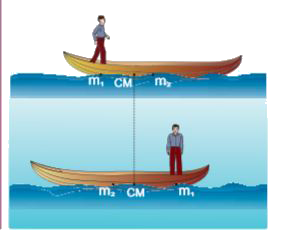
[Given: There is friction between the man and the boat and no friction between the boat and water.]
View SolutionA projectile of mass 5 kg, in its course of motion explodes on its own into two fragments. One fragment of mass 3 kg falls at three fourth of the range R of the projectile. Where will the other fragment fall?
View SolutionIf the force applied is perpendicular to the handle of the spanner as shown in the diagram, find the (i) torque exerted by the force about the center of the nut, (ii) direction of torque and (iii) type of rotation caused by the torque about the nut.
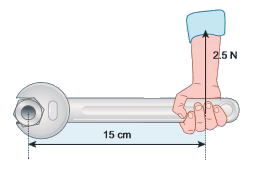
View SolutionA force of `(4hati-3hatj+5hatk)` N is applied at a point whose position vector is `(7hati+4hatj-2hatk)` m. Find the torque of force about the origin.
View SolutionA crane has an arm length of 20 m inclined at `30^(@)` with the vertical. It carries a container of mass of 2 ton suspended from the top end of the arm. Find the torque produced by the gravitational force on the container about the point where the arm is fi xed to the crane. [Given: 1 ton = 1000 kg, neglect the weight of the arm. g = 10 m `s^(-2)`]
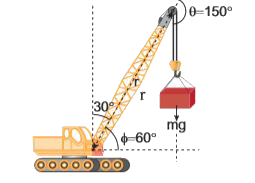
View SolutionThree mutually perpendicular beams AB, OC, GH are fixed to form a structure which is fi xed to the ground fi rmly as shown in the Figure. One string is tied to the point C and its free end D is pulled with a force F. Find the magnitude and direction of the torque produced by the force,

about the points D, C, O and B
View SolutionThree mutually perpendicular beams AB, OC, GH are fixed to form a structure which is fi xed to the ground fi rmly as shown in the Figure. One string is tied to the point C and its free end D is pulled with a force F. Find the magnitude and direction of the torque produced by the force,
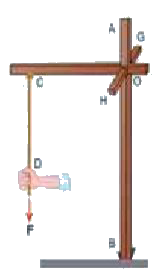
about the axes CD, OC, AB and GH.
View SolutionA particle of mass (m) is moving with constant velocity (v). Show that its angular momentum about any point remains constant throughout the motion.
View SolutionArun and Babu carry a wooden log of mass 28 kg and length 10 m which has almost uniform thickness. They hold it at 1 m and 2 m from the ends respectively. Who will bear more weight of the log? [g = 10 `ms^(-2)`]
View SolutionA cyclist while negotiating a circular path with speed 20 m `s^(-1)` is found to bend an angle by `30^(@)` with vertical. What is the radius of the circular path? (given, g = 10 m `s^(-2)`)
View SolutionFind the moment of inertia of a uniform rod about an axis which is perpendicular to the rod and touches any one end of the rod.
View SolutionFind the radius of gyration of a disc of mass M and radius R rotating about an axis passing through the center of mass and perpendicular to the plane of the disc.
View SolutionFind the moment of inertia of a disc of mass 3 kg and radius 50 cm about the following axes.
axis passing through the center and perpendicular to the plane of the disc,
View SolutionFind the moment of inertia of a disc of mass 3 kg and radius 50 cm about the following axes.
axis touching the edge and perpendicular to the plane of the disc and
View SolutionFind the moment of inertia of a disc of mass 3 kg and radius 50 cm about the following axes.
axis passing through the center and lying on the plane of the disc.
View SolutionFind the moment of inertia about the geometric center of the given structure made up of one thin rod connecting two similar solid spheres as shown in Figure.
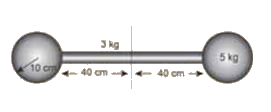
View SolutionA disc of mass 500 g and radius 10 cm can freely rotate about a fixed axis as shown in figure. light and inextensible string is wound several turns around it and 100 g body is suspended at its free end. Find the acceleration of this mass. [Given: The string makes the disc to rotate and does not slip over it. g = 10 m `s^(-2)`.
View SolutionA jester in a circus is standing with his arms extended on a turn table rotating with angular velocity `ω`. He brings his arms closer to his body so that his moment of inertia is reduced to one third of the original value. Find his new angular velocity. [Given: There is no external torque on the turn table in the given situation.]
View SolutionFind the rotational kinetic energy of a ring of mass 9 kg and radius 3 m rotating with 240 rpm about an axis passing through its center and perpendicular to its plane. (rpm is a unit of speed of rotation which means revolutions per minute)
View SolutionA rolling wheel has velocity of its center of mass as 5 m `s^(-1)`. If its radius is 1.5 m and angular velocity is 3 rad `s^(-1)`, then check whether it is in pure rolling or not.
View SolutionA solid sphere is undergoing pure rolling. What is the ratio of its translational kinetic energy to rotational kinetic energy?
View SolutionFour round objects namely a ring, a disc, a hollow sphere and a solid sphere with same radius R start to roll down an incline at the same time. Find out which object will reach the bottom first.
View Solution
EXAMPLE SOLUTION questions and complete solutions for chapter MOTION OF SYSTEM OF PARTICLES AND RIGID BODIES of FULL MARKS PHYSICS(TAMIL) of Class 11